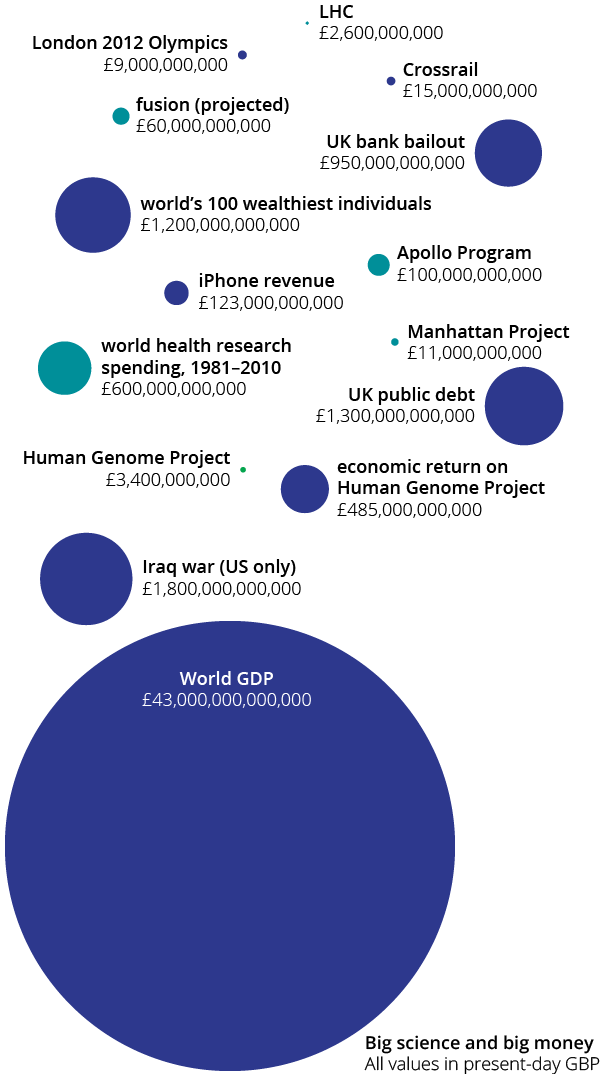Big science
Spending billions on big scientific goals might sound costly, but we routinely spend much larger sums on everything from wars to sporting events.
It’s quite common to think of scientific breakthroughs as a number of years away: fusion will be powering homes in 50 years, we might have cured cancer by the end of the century, and so on. However, scientific discoveries can only be made if you try: no amount of hours spent not looking for a cure for cancer will find one. It makes more sense to think of us being a number of person-hours, or even a certain investment, away from the next giant leap.
It’s therefore worth stepping back from the pounds per person per year framework for a moment to consider the total amounts required to solve some of the big problems in science. To provide a sense of scale, they can be compared to the price tag of other large national and international projects.

- The iPhone is a phenomenally successful piece of technology, grossing over £120 billion since it was launched in 2007. It’s very probable that we could have developed fusion with that much money (it’s more than double the estimated cost of doing so).
- The world’s 100 wealthiest people could join forces to add a few years to global life expectancy, develop fusion and send people to the Moon, and still have change for a mansion or six.
- The UK bank bailout, at its height in 2009, saw the government underwriting the banks to the tune of nearly one trillion pounds: half as much again as the amount of public money spent on health research, worldwide from 1981–2010.
We’re not calling for iPhone owners to donate their next upgrade or for a League of Billionaire Science Philanthropists here (though those things could be cool); these comparisons are intended to illustrate how small science spending seems in the context of our global finances.
Making these numbers fit the Scienceogram methodology of pounds per person per year can be tough, because many of the projects above were done by (and for) different numbers of people. However, acquiring knowledge is an international collaborative endeavour; to some extent, it doesn’t matter where a particular piece of research is done. If you take a look at the scientific projects with this in mind, big discoveries look tantalisingly close.

A simple approximation is to divide these figures by the population of the ‘high-income countries’, some 1.1 billion people. As discussed on the Energy page, developing fusion power will probably set us back around £60 billion—which is just £50 each.
The problem with predictions
All predictions about future scientific discoveries are terribly unreliable. It’s even hard to generalise: we might expect future discoveries to be more expensive than past ones because we’ve already found all the easy stuff; but then, our advanced tools, techniques and accrued knowledge allow us to probe reality faster and more wisely than we have in the past, which could end up making discovery cheaper.
Though it makes sense to plan and draw a roadmap to cracking fusion, we can’t be sure that we’ll have an affordable power source at the end of it. Equally, it’s hard to extrapolate the cost of future medical breakthroughs by looking at how much it cost in the past. However, even if scientific discovery does turn out to be several times more expensive in the future than it has been thus far, it’s still pretty cheap compared to other collaborative international endeavours—and the payoff from a small investment is potentially enormous.
This gives us an impression of what’s going on globally: how do individual countries stack up? We investigate this in the International comparisons section.